Webmaster of Jack
Bog's Blog
All Photos from Michael Dobrzelecki
When it comes to nostalgia, not much beats the internet. Over the
holidays I wrote about buying our Christmas tree, from a guy named
Whitey up the street from us, when we were growing up in "Down
Neck" Newark. Whitey's son Michael soon stumbled across that
post, and he left a nice comment, filling in some details that I
had left out and properly correcting me on a few points.
More recently, I got an e-mail message from Mike in which he explained
that he still drops into the old neighborhood every now and then.
Best of all, he sent along some recent photos that show what the
place is like now.
Here's how Whitey's old home looks these days:
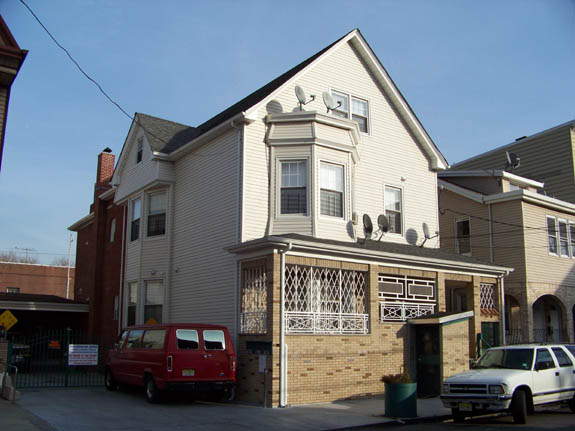
There's the driveway where the cat spoiled our tree:
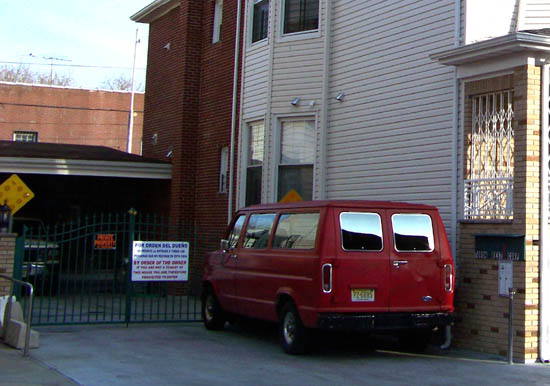
The gate has been pushed back a bit -- it used to be flush with
the front of the house -- and that porch-like thing with the wrought
iron wasn't there back in the day. There used to be some greenery
-- I'm thinking maybe rose bushes or a little garden -- along the
drive next to the house. And that's a huge recent addition in the
back -- Mike referred to the remodeled version as "a house
on steroids."
Here's another angle, looking south. Our four-plex was on the same
side of the street, but it would be one of those waaaay down on
the right edge of this photo:
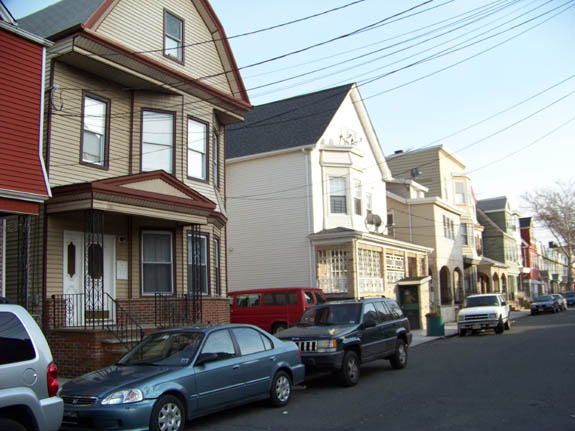
One thing you don't see much of there is trees. Mike explains:
When we were growing up, the street was tree-lined, providing a
shady canopy in summer. There was a huge maple tree in front of
my house at 20 Cortland Street. It is gone now. The Portuguese and
Brazilian immigrants have a very different view of greenery than
the former Ironbound residents. They have a tendency to pave over
their small backyards, creating a walled-in concrete palazzo. Most
trees are ripped out -- even the ones they do not really own out
in front....
Portuguese/Brazilian culture has many other things to recommend
it. For one thing, their restaurants are great, they have a strong
family ethic and the music is wonderful. They are a vibrant addition
to the neighborhood and the city owes them a debt of gratitude for
keeping the Ironbound section a step above the rest of Newark.
Michael also took a couple of shots of the schoolyard of the public
Hawkins Street School across the street. It was here that we kids
whiled away many after-school hours and hung out all summer long,
even though most of us attended Catholic schools. He writes:
Turning right onto Cortland offers a mostly familiar scene with
Hawkins Street School on the right where we used to play paddle
ball, touch football, basketball and that quintessential urban game
so popular in New York City and Newark -- stickball, which, for
the benefit of all the "outlanders" on the west coast,
is played with a broom stick as a bat, a pink Spalding Hi-Bouncer
for a ball and the strike zone represented by a rectangular box
drawn in chalk on the side of a building. In our neighborhood, since
stickball was such an institution, the strike zone was painted permanently
on the side of Hawkins Street School brick wall facing Cortland
Street.
The schoolyard is smaller, and not just because I am bigger than
when I was 12 years old. They have added onto some of the buildings
over the years crowding out the main play area.
Here's a part of the schoolyard that, except for the security camera
and the paint on the building (which was plain brick in our day),
hasn't changed in 50 years:
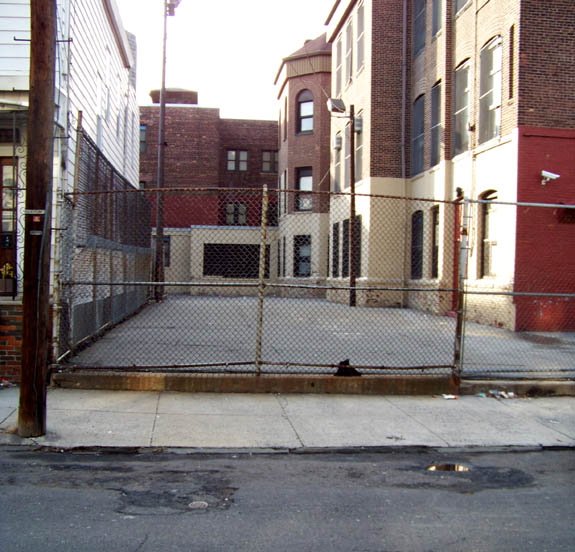
This narrow area, on the edge of the school property, was excellent
territory. I still have a scar on my knee to show for an evening
when I was tearing around that corner of the building (running toward
the camera in this view, and turning to your right). I hit some
loose dirt near one of the drains in the blacktop, and dressed as
I was in short pants, I left a chunk of knee skin behind.
Although the main after-school activities were centered on another
part of the yard, many a game was played here, including some that
Mike did not mention. For example, this side of the schoolyard,
which the supervisors didn't frequent, was a good spot for the forbidden
game "Hide the Belt," which mostly involved kids whipping
each other.
Someone had also invented a sanctioned game called "Hit Off
the Point." This involved the slate ledge that ran along the
side of the building, just below the windows at ground level. One
kid would be offense, and one would be defense. The offensive player
would stand next to the wall and slam a Spaldeen against the "point"
at close range. It was the defensive player's job to try to catch
it on the fly, which would be an out. If he failed to do so, the
ball was a single, double, triple, or home run, depending on how
high or far it went. As you can see, on this side of the schoolyard
the house next door was mighty close, and so a safe hit was judged
a single, double, etc., based on how high it hit off the house or
fence. Of course, it was legal for the defender to catch the ball
off the house or fence for an out, so long as it didn't hit the
ground first.
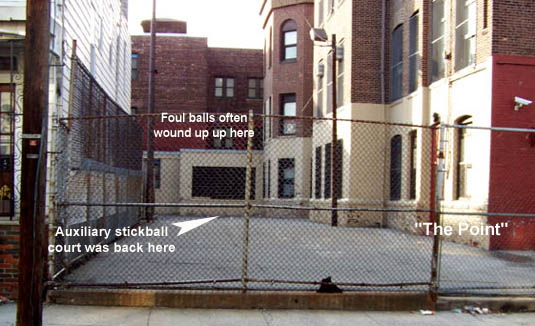
Another interesting thing we did was play stickball on a little
"auxiliary" court down at the end of this stretch of schoolyard,
along the wall in the background of this photo. The yard actually
extends a little to the left around the corner down the far end
of the cyclone fence, and there was just enough space there for
a narrow little stickball court next to a fire escape. (The main
stickball action was in another part of the yard.) The hitter stood
in the back there, facing right to left, and the pitcher was throwing
from outside this photo, left to right, with his back to the building,
just inches away. This was another spot where you couldn't hit the
ball for distance, and so the game was to see how high you could
hit it. Onto the roof of the three-story building that the pitcher
stood in front of -- that was a home run.
By the way, there was no running bases in "Hit Off the Point"
or our version of stickball. It was all hitting on offense, and
all pitching and catching on defense. We did have some games that
involved base running, but not in this area of the yard.
Anyway, there were several hazards to playing on the auxiliary
stickball court. One was that there was a single-story portion of
the school building all along the court right next to the pitcher's
spot and the batter's box, and so many a foul ball wound up on the
roof of that part of the building. If your ball got stuck up there,
you'd have to climb up the outside of the building and get it, which
was way against schoolyard rules. But most of us kids were already
practiced in climbing the fence to get into the schoolyard when
it was closed, and as I said, the teachers didn't get back here
much, and so somebody always braved it. There were cages on the
windows and a little pipe of some kind to hold onto. I think I may
have done it once, but generally I left that task to others. Although
I hopped the fence hundreds of times to play in the schoolyard when
it was closed, I never did like climbing that wall. (If no one was
brave enough to go up there and there was only one ball, that was
the end of that game. The next kid who climbed up would find two.)
Another hazard was that fair balls often landed in the yards of
the folks who lived on the west side of Cortland Street, and you'd
have to hop their fence or ring their doorbell to retrieve those.
I believe it was one such fair ball that provoked an incident that
is still discussed within my family to this day.
One of us boys had hit a Spaldeen or a sponge ball into Joe Browarski's
yard. That was quite a hit, because he lived way down across from
us at no. 35. Mr. Browarski was known to most neighbors as "Dziadzia,"
meaning "Grandpa" in Polish and definitely at that time
and place pronounced "JAH-jee." Now, Jahjee was, shall
we say, more than a wee bit territorial. For example, he had a homemade
sign on his front gate that said "No Parking or Turning in
Driveway." O.k., we could all see the no parking part, but
no turning? That was Jahjee.
He, like Whitey, also had a big, snarling dog who didn't take to
strangers. And so if a kid hit a ball in Jahjee's yard, there was
no sneaking in to get it out. You'd need a grownup's help. When
we rang the bell, hoping against hope that Mrs. B. would be on sentry,
instead out onto the porch stepped Jahjee, who when informed of
our predicament, replied -- and I quote -- "If you want your
goddamn ball go get your goddamn mother."
Here's a slightly different angle from roughly the same vantage
point:
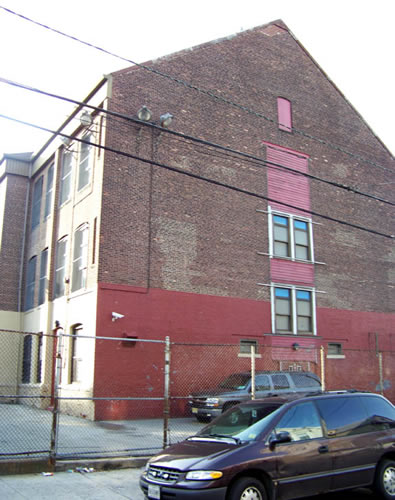
This view saddens me a bit. That van parked inside the fence next
to the building is sacrilegious. There used to be a basketball hoop
up on that wall, and another one down the wall to the right as well.
In front of each basket were painted 15 little circles, where we
used to play a game called "numbers." The object was to
shoot a basket from each of the 15 spots, in numerical order, before
your opponent did. You took turns. If you made a number, you got
to go on to the next. If you missed, you stopped and it was your
opponent's turn. For beginners, when you missed on a number, you
started at that number when it was your turn again; for advanced
players, when you missed, you had to go back and start at no. 1.
There was a second "point" game played along that wall
as well. At the base of the schoolyard fence, there is a little
curb, and we used stand in front of that curb and bounce off it
at close range a brown ball about the size of a basketball but with
a skin more like that of a soccer ball or volleyball. One's opponent
would stand in front of the wall and try to catch the ball after
it flew up from the curb but before it hit the ground. It was just
another version of "Hit Off the Point," but the ball was
bigger, and there were bonus features. For instance, if the ball
hit that painted vent you see on the wall near the security cam,
that was 5 runs, as opposed to the 1 run you'd get for a simple
uncaught hit off the wall. (The vent there is attached to the girls'
restroom; there's another one down to the right, just out of range
of this shot, and it is attached to the boys'.) If your opponent
caught the ball after it hit the vent, I think you'd still get 2
or 3 runs, but it would be an out. When the ball hit that thing,
it would make a satisfying, mildly destructive sound, not unlike
a dropped metal garbage can.
If the ball was hit hard enough to hit the wall and make it all
the way back to hit the fence, that was 2 runs. If it hit the wall
and flew back over the fence, onto Cortland Street -- which a few
of the big kids like Mike's oldest brother could do -- I think that
was 5 or 10 runs. A hit off the loud aluminum basketball backboard
was another bonus (I forget how much), and actually placing the
ball in the basket was something like 15 or 20 runs. Actually, the
game was a little better down at the other end of the building,
just to the right of this shot, where the curb is a little higher
and we aimed for the boys' room vent, but you get the picture.
Michael also included a present-day photo of nearby Hayes Park
East Pool, known to us kids simply as "Hayes Pool." If
you were a "youth" in our part of Down Neck, this was
the place to hang out all summer, every summer, unless you were
in the schoolyard or down the shore. (It is also the scene of the
famous raid in which we stole a large loudspeaker, only to discover
that we didn't want it.) The place is looking pretty forlorn these
days, although it always did in winter:
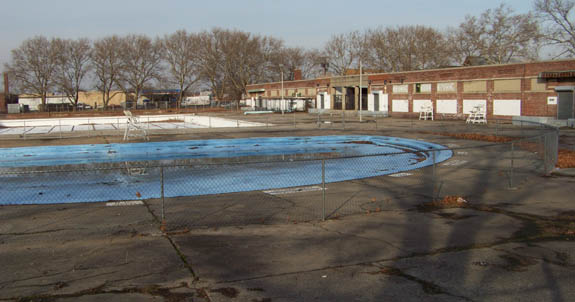
In the foreground is the the "kiddie pool," and the lighter-color
pool (the two were the same color in those days) is what we used
to call the "middle pool." The latter is about 3½
feet deep around the edges and around 4 in the center. In the background,
there used to be a third pool, the size of the kiddie pool or even
larger, called the "diving pool." It had four diving boards
-- two low and two high. The high boards were pretty darn high --
a good 20 feet -- and the pool was very deep -- probably 25 feet
at the deepest. That third pool is gone now, done in by liability
concerns, no doubt. In our time, it was open for only brief periods
each day, and our friends who were lifeguards were always pulling
people out of there would couldn't swim. (It was also a great place
to stash beer on hot nights.) I wasn't much of a diver, and so my
only moves "off the high" were cannonballs and can openers.
Those are the locker room buildings over on the right -- women in
the foreground, men in the back.
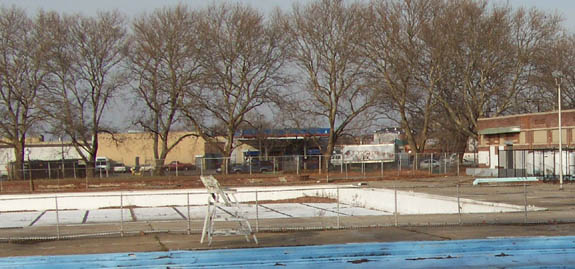
Way in the background here, across busy Raymond Boulevard, is an
old gas station at which I spent many, shall we say, formative evenings
in my early adolescence. It was called "D & L" or
"Dave's," and a couple of my bigger, stronger buddies
worked there as mechanics. Right behind it, some highly toxic substances,
mostly dioxin, were being released into the environment on a regular
basis by some chemical companies, but we were blissfully ignorant
of all that at the time.
Finally, here's a familiar view for me. This photo is taken looking
west on Ferry Street, just as it approaches Hayes Pool:
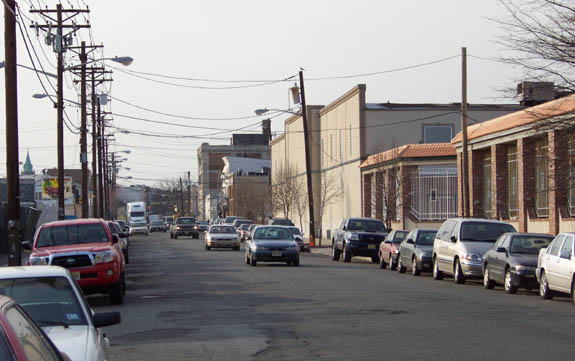
Some of my best friends in grammar and high schools lived in a large
three-story walkup that used to sit just to the left of this photo.
625 Ferry was headquarters for us as teens. We used to lounge on
the big brick front porch night after night, listening to the radio,
smoking cigarettes, making out, hanging out. Their building is gone
now, and I don't recognize a couple of those structures on the right,
where the fire extinguisher place used to be, but that relentless
one-way traffic in the distance, just launched from a traffic light,
is the same as ever. This was where we watched the National Guard
drive out of Newark after the race riots. And back there on the
left is the steeple of our old church, St. Aloysius, where all the
choir and altar boy action went down.
Thanks, Mike, for bringing it all back to life.
|

